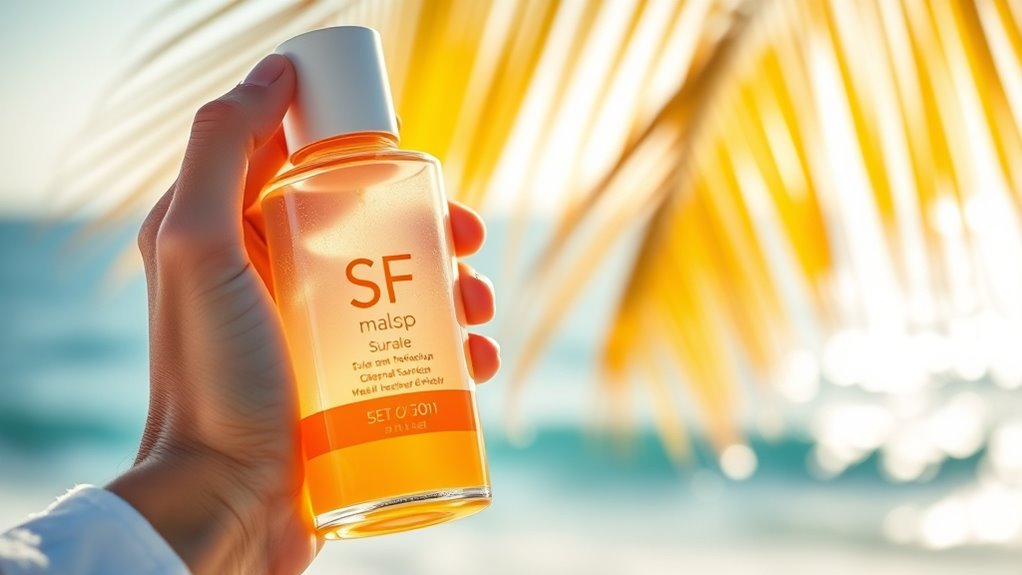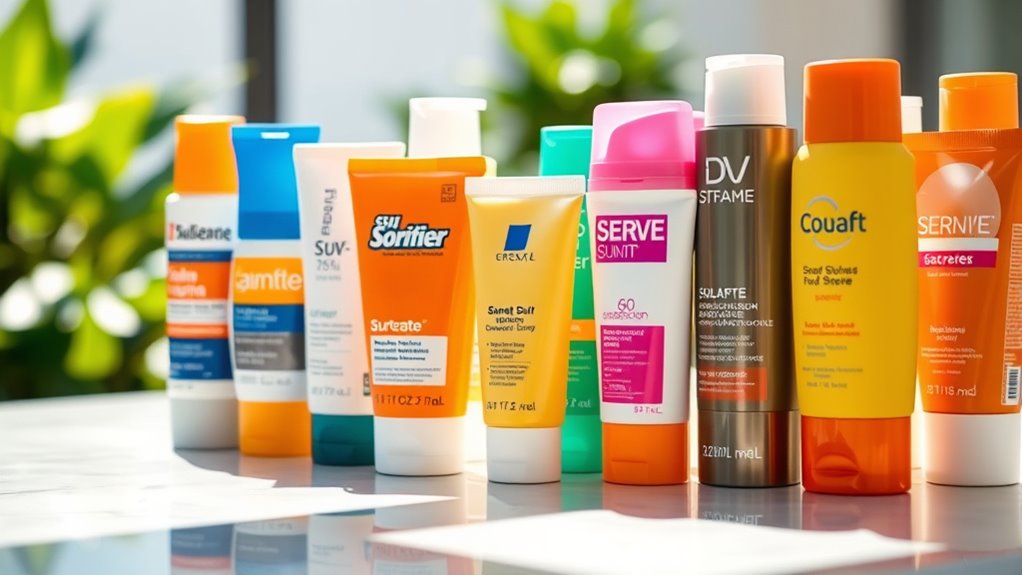To pick the perfect sunscreen, look beyond the SPF number and choose a broad-spectrum formula that protects against both UVA and UVB rays. Focus on ingredients like zinc oxide or titanium dioxide, which are safe and effective mineral filters. Remember, higher SPF doesn’t mean much without proper application and reapplication every two hours. Keep these tips in mind, and you’ll be well on your way to safer, more effective sun protection. If you want to learn more, there’s always more to discover.
Key Takeaways
- Choose broad-spectrum sunscreens with at least SPF 30 for comprehensive UVA and UVB protection.
- Prioritize mineral ingredients like zinc oxide or titanium dioxide for safer, less allergenic options.
- Remember higher SPF extends protection time but doesn’t block all UV rays; reapply every two hours.
- Ensure the product is water-resistant if you’ll be sweating or swimming for effective outdoor use.
- Proper application and consistent reapplication are essential to maximize sunscreen efficacy and protect your skin.

Ever wondered what really makes SPF work? It all comes down to its ability to provide effective UV protection, which is essential for preventing skin damage and reducing the risk of skin cancer. When choosing a sunscreen, you need to understand that UV protection isn’t just about the SPF number; it’s about how well the product shields you from both UVA and UVB rays. UVA rays penetrate deeper into the skin and contribute to aging, while UVB rays are primarily responsible for sunburn. A broad-spectrum sunscreen ensures you’re protected from both, but the real secret lies in the ingredients that deliver this defense.
Effective SPF provides UV protection beyond the number—look for broad-spectrum ingredients that shield against UVA and UVB rays.
You should pay close attention to ingredient safety, too. Not all sunscreen ingredients are created equal, and some can cause irritation or have long-term health concerns. Dermatologists often recommend mineral sunscreens with zinc oxide or titanium dioxide because these ingredients sit on top of the skin and reflect UV rays, providing a physical barrier. They’re generally considered safer and less likely to cause allergic reactions. On the other hand, chemical filters like oxybenzone or avobenzone absorb UV rays and convert them into heat, which can sometimes cause skin irritation or other issues, especially if you have sensitive skin.
When selecting a sunscreen, look for labels that specify it’s broad-spectrum and offers at least SPF 30. Higher SPFs might seem appealing, but they don’t necessarily provide proportionally more protection; they just last longer. Remember, no sunscreen blocks 100% of UV rays, so it’s crucial to reapply every two hours or immediately after swimming or sweating. The formulation also matters—water-resistant options are a good choice if you’re active outdoors.
Another aspect to think about is ingredient safety beyond UV protection. Some ingredients in sunscreens can be absorbed into the bloodstream, raising concerns about potential hormonal effects. While research is ongoing, many dermatologists prefer mineral-based formulas because they tend to be safer and more stable under sunlight. Always opt for products from reputable brands that follow safety guidelines and have transparent ingredient lists.
Additionally, understanding the importance of tuning in vehicle performance can be a helpful analogy; just as selecting the right ingredients and proper application enhances sunscreen effectiveness, tuning your car’s engine and components can optimize its efficiency and protection. Always remember, choosing the right SPF isn’t just about the number on the bottle; it’s about understanding how the ingredients work, their safety, and how well they protect your skin. By prioritizing broad-spectrum coverage, ingredient safety, and proper application, you can enjoy the sun while keeping your skin healthy and protected for years to come.
Frequently Asked Questions
Can SPF Ratings Be Misleading or Overstated?
You might wonder if SPF ratings can be misleading or overstated. Sadly, SPF accuracy isn’t always perfect, and some products have misleading labels that overstate their protection. Always check the ingredients and test the product yourself, rather than relying solely on the label. Remember, higher SPF doesn’t mean you can stay in the sun longer without reapplying. Be cautious and choose sunscreens with transparent, verified SPF ratings for true protection.
How Often Should I Reapply Sunscreen During the Day?
Think of your sunscreen as a shield that needs regular reinforcement. You should reapply every two hours, especially if you’re swimming, sweating, or towel-drying. Proper application timing matters to keep your skin protected. Don’t forget to reapply more often if you’ve been outdoors for extended periods. Staying vigilant guarantees your shield remains strong, giving you continuous protection from harmful UV rays throughout the day.
Is Water-Resistant Sunscreen Truly Waterproof?
Water-resistant sunscreens are designed to withstand water exposure for a certain period, but they’re not truly waterproof. Waterproof claims mean the sunscreen can resist water or sweat during activities like swimming or intense exercise, but it’s not completely impervious. You should reapply after swimming, sweating heavily, or towel drying to maintain protection. Always check the label’s water resistance duration to make sure your skin stays protected during water exposure.
Are Natural or Mineral Sunscreens Better Than Chemical Ones?
Think of natural or mineral sunscreens as your skin’s gentle guardians, like a calm lake versus a stormy sea. Natural vs chemical sunscreens each have benefits, but mineral sunscreens offer advantages like fewer irritants and broad-spectrum protection, making them ideal for sensitive skin. Mineral sunscreen benefits include quick absorption, no harsh chemicals, and a barrier that reflects UV rays. You’ll love how they protect without causing unnecessary reactions.
How Does SPF Interact With Other Skincare Products?
When it comes to SPF and other skincare products, you need to consider chemical interactions and product layering. Some ingredients in your serums or moisturizers can reduce SPF effectiveness or cause irritation. To avoid this, apply your sunscreen last after layering your skincare. Wait a few minutes between products to allow absorption. This ensures your SPF works properly and your skin stays protected without negative chemical reactions.
Conclusion
Now that you know the secrets to choosing the perfect sunscreen, think of it as your shield in a sunlit armor. With every swipe, you’re crafting a barrier against the blazing rays, like a fortress protecting your skin’s precious interior. So, embrace your new knowledge and let your sunscreen be your trusty companion, turning every sunny day into a safe journey. Protect your skin, and keep your glow shining bright—your future self will thank you.









